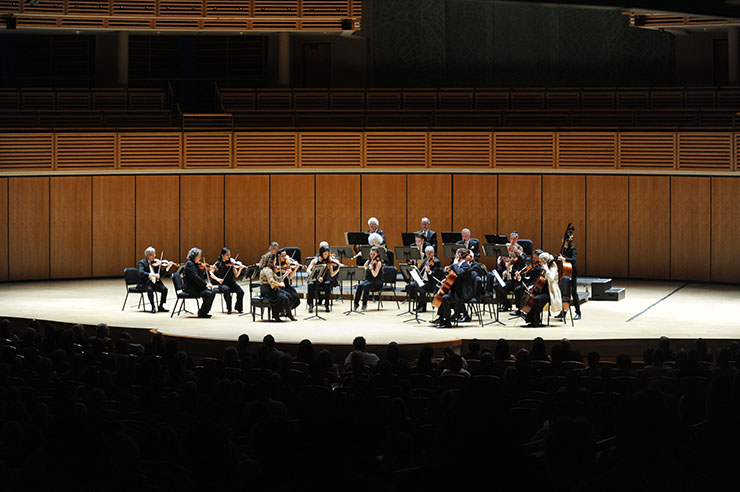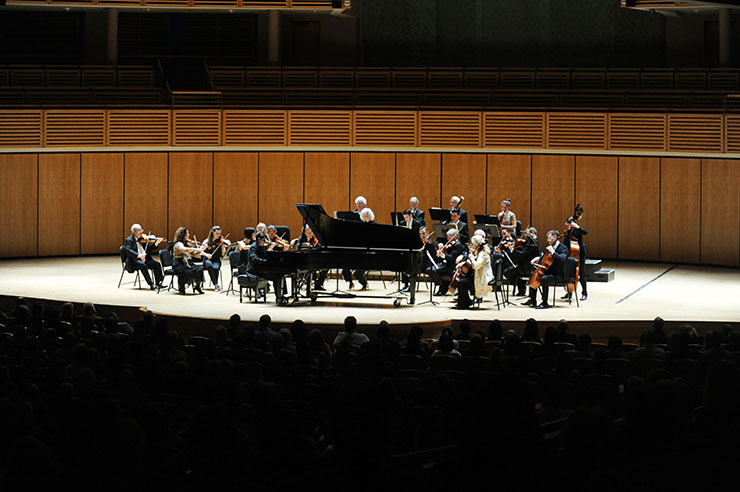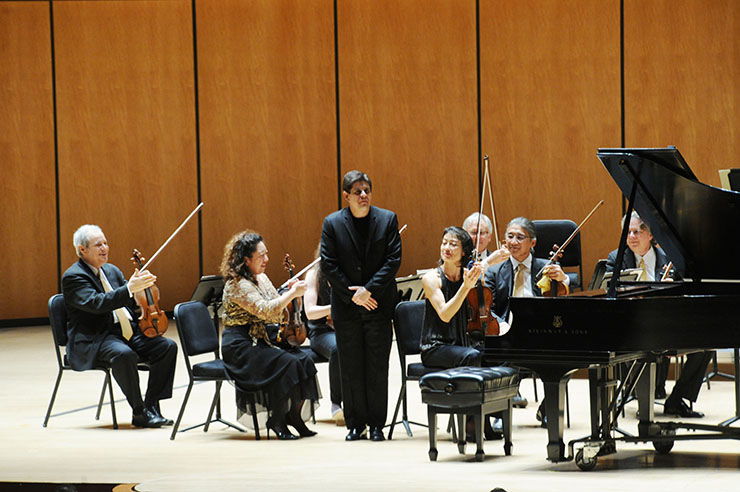By the age of 35, Mozart, the undisputed heavyweight champion of musical productivity, produced a vast oeuvre of over 600 works which included operas, symphonies (a whopping 41 of them), string quartets, religious music, sonatas, dances, songs and oh yes, 27 original concertos for piano and orchestra. The Orpheus Chamber Orchestra, featuring pianist Javier Perianes, offered up #27 to a capacity Miami crowd on Saturday, Jan. 5, at the Knight Concert Hall.

Photo by WorldRedEye.com/Courtesy of the Arsht Center.
Taking their name from Orpheus, musician and poet from Greek mythology with the ability to charm all living things (even stones!) with his divine music, the Orpheus Chamber Orchestra lived up to that legendary high bar. The 25 players on stage moved as one body, operating with the efficiency of a string quartet and the dynamics of a full orchestra, clean with every passage entrance and exit.
With a bent toward both tradition and innovation, Orpheus retools larger classic pieces, reimagining them for chamber orchestra, which sports less than half of the players of a traditional symphony. As well, they perform commissioned and original works, appearing annually at Carnegie Hall and touring nationally and internationally, connecting with a worldwide audience. They have collaborated with such luminaries as Itzhak Perlman, Yo-Yo Ma and Emanuel Ax. Their canon is loaded with classics from Handel and Beethoven through Copland and Stravinsky. Several of the players hold teaching positions at conservatories and universities such as Juilliard, Manhattan School of Music, New England Conservatory, Columbia and Yale. It's safe to say that every player on stage is at the top of their game.
With over 70 albums to its credit and several Grammy Awards, the Orpheus Chamber Orchestra, founded in New York City in 1972, was formed with no principal conductor at the helm. No maestro? Yes, Orpheus maintains a democratic workplace. They slant toward a collaborative leadership style in which “the musicians, not a conductor, interpret the score,” rotating the pilot for each work. Several of the violinists played musical chairs with the concert master seat, the leadership changing with each piece on the program.
“Still Life,” a new commissioned work by James Matheson, connoted two meanings: suggesting the inanimate subject of a still life work of art, and “still life,” speaking to the division of polarized groups “in our political and social system today.”

Photo by WorldRedEye.com/Courtesy of the Arsht Center.
Matheson succeeded in creating the movement and discord he set out in his narrative, Orpheus sustaining an orchestral note which was followed by chattering winds, combining with strings in a dissonant forward progression. Solo instruments, such as clarinet and horn, helped to create a nervous tension, intermittently poking through the sound-cloud. It was the complexity of the arrangement in a seemingly simple form, with shimmering activity in the details of the work, that maintained interest in how it would resolve. And resolve it did, with a satisfying assent on a positive note. Though it was hard to grasp a melody, there was a rational progression to the piece; certainly worth a second listen.
Dennis Russell Davies arrangement of Dvorák’s "Bagatelles,” began with the Orpheus players passing around a pleasant melody, reflecting the mellow character of the short pieces Dvorák composed as a suite of “Miniatures” for friends to play at home. The melody often simmered in a savory broth, seasoned with little surprises – an oboe and horn counterpoint here, sweeping strings there – the set of compositions favored by the audience.
Two Mozart works highlighted the program.
Pulling the great potential out of the piano, paving the way for virtuosi such as Chopin, Liszt and Rachmaninoff, there is no doubt that Mozart, adapting music to a new aesthetic, kicked the piano into a new and everlasting gear, evinced in his Piano Concerto No. 27, his final concerto before his untimely death in 1791.

Photo by WorldRedEye.com/Courtesy of the Arsht Center.
Spanish pianist Javier Perianes is one of those remarkable players whose touch is both at once light and expansive, avoiding the heavier hands of other artists. His interpretation of #27 was magnificent.
The orchestra was smooth and flawless at the top as Perianes entered the conversation with his bright and precise technique, like the first rays of sunlight that come streaming through an early morning window. Perianes played as if he had nothing to prove, and he did have nothing to prove, because it was all there in the relaxed ease of his nimble fingers. He picked the individual notes carefully and executed his runs and arpeggios effortlessly, exploiting the first movement cadenza with delicate confidence.
Perianes introduced the lovely melody echoed by the orchestra in the slower second movement, perhaps a meditation, simple in texture and blossoming naturally into the second theme, his touch the payoff on returning to the first figure.
The lively third saw more muscular runs, still every note respected, Perianes covering the entire keyboard as he nailed his cadenza. He was fully appreciated by the audience, both understated and ringing true, landing beautifully with every note.
It’s easy to hear the influence Mozart had on Beethoven’s symphonic output, especially the realized and rich interplay between the strings and woodwinds – tidy and on full display in Mozart’s Symphony No. 33, a work he completed in his early 20s.
You certainly must be well connected consciously and emotionally to one another to be as synchronized as the 25 members of Orpheus were in acquitting Mozart’s No. 33. Be it the playful leaps and swoops of the first, the spacious harmonics of the strings and winds in the second, the pleasant dance of the Menuetto, and the driving force of the finale, Orpheus played this one as Mozart might have intended and heard it.
And what would be a more fitting encore for Orpheus than Gluck’s ‘Dance of the Furies’ from “Orfeo ed Euridice”? The players literally moved as one, furiously attacking the notes, their fearless, bold and precise approach bringing the crowd to its feet.
 MAIN MENU
MAIN MENU

